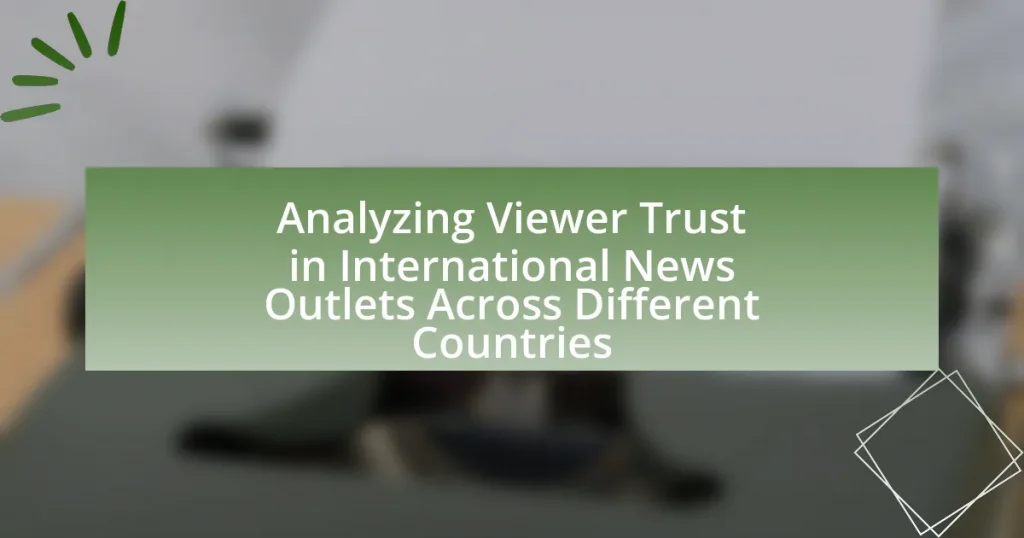The article analyzes viewer trust in international news outlets, highlighting the factors that influence this trust, including perceived credibility, transparency, and the reputation of the news source. It examines how cultural differences, national media landscapes, historical events, and demographic factors shape perceptions of news credibility across various countries. Key indicators of trust, such as accuracy and accountability, are discussed, along with the impact of social media and audience engagement on trust levels. The article also outlines strategies for news organizations to build and maintain viewer trust in a rapidly evolving media environment.

What factors influence viewer trust in international news outlets?
Viewer trust in international news outlets is influenced by factors such as perceived credibility, transparency, and the outlet’s reputation. Research indicates that audiences are more likely to trust news sources that consistently provide accurate information and disclose their sources, as seen in studies by the Pew Research Center, which found that 62% of respondents value transparency in reporting. Additionally, the reputation of the news outlet plays a critical role; established organizations with a history of reliable reporting tend to garner more trust. Furthermore, audience demographics, including age and education level, also affect trust levels, with younger viewers often showing skepticism towards traditional media compared to older generations.
How do cultural differences impact perceptions of news credibility?
Cultural differences significantly impact perceptions of news credibility by shaping how individuals interpret information based on their societal norms and values. For instance, in collectivist cultures, such as those in East Asia, news is often viewed through the lens of community impact and harmony, leading to a higher trust in state-sponsored media that aligns with these values. Conversely, in individualistic cultures like the United States, skepticism towards government narratives may lead to a preference for independent news sources, which are perceived as more credible. Research by the Reuters Institute for the Study of Journalism indicates that trust in news varies widely across countries, with cultural context influencing whether audiences prioritize factual accuracy or alignment with personal beliefs. This demonstrates that cultural frameworks not only affect the interpretation of news content but also the overall trust in various news outlets.
What role does national media landscape play in shaping trust?
The national media landscape significantly influences public trust in news sources. A diverse and independent media environment fosters higher levels of trust among viewers, as it provides multiple perspectives and reduces the likelihood of biased reporting. For instance, countries with a high degree of press freedom, such as Norway and Sweden, consistently report higher trust levels in media compared to nations with restricted media environments, like North Korea or China, where state-controlled narratives dominate. Research by the Reuters Institute for the Study of Journalism indicates that trust in news is closely linked to perceptions of media independence and transparency, highlighting the critical role that the national media landscape plays in shaping public confidence in news outlets.
How do historical events affect current trust levels in news outlets?
Historical events significantly influence current trust levels in news outlets by shaping public perception and credibility. For instance, events such as the Watergate scandal in the 1970s led to a decline in trust towards mainstream media in the United States, as it exposed issues of bias and misinformation. Similarly, the coverage of the Iraq War in the early 2000s resulted in skepticism regarding the accuracy of news reporting, as many outlets were criticized for disseminating unverified information. These historical instances create a lasting impact on how audiences evaluate the reliability of news sources today, often leading to increased scrutiny and a preference for alternative media that align with their views.
What are the key indicators of trust in news media?
Key indicators of trust in news media include transparency, accuracy, accountability, and impartiality. Transparency refers to how openly a news organization shares its sources and decision-making processes, which fosters trust among audiences. Accuracy is crucial, as consistent reporting of factual information builds credibility; for instance, a 2021 study by the Reuters Institute found that 62% of respondents valued accuracy as a primary factor in their trust in news outlets. Accountability involves the willingness of media organizations to correct errors and address public concerns, which enhances their reliability. Lastly, impartiality, or the fair representation of diverse viewpoints, is essential; research indicates that audiences are more likely to trust media that present balanced perspectives, as shown in a 2020 Pew Research Center survey where 70% of participants expressed distrust in news that appears biased.
How do transparency and accountability influence viewer trust?
Transparency and accountability significantly enhance viewer trust by fostering an environment of openness and reliability. When news outlets openly share their sources, methodologies, and decision-making processes, viewers are more likely to perceive the information as credible. Research indicates that 73% of audiences are more likely to trust media organizations that are transparent about their operations and funding sources. Furthermore, accountability mechanisms, such as corrections and public responses to criticism, reinforce trust by demonstrating that the outlet values accuracy and is willing to rectify mistakes. This combination of transparency and accountability creates a foundation for trust, as viewers feel more secure in the integrity of the information presented to them.
What is the impact of journalistic standards on audience perception?
Journalistic standards significantly influence audience perception by establishing credibility and trustworthiness in news reporting. High journalistic standards, such as accuracy, fairness, and transparency, lead audiences to perceive news outlets as reliable sources of information. Research indicates that audiences are more likely to trust news organizations that adhere to these standards, as evidenced by a 2021 study from the Reuters Institute for the Study of Journalism, which found that 71% of respondents in countries with strong journalistic practices reported higher trust levels in their news sources. Conversely, low standards can result in skepticism and distrust, diminishing the perceived reliability of the information presented.
Why is viewer trust important for international news outlets?
Viewer trust is crucial for international news outlets because it directly influences audience engagement and credibility. High levels of trust lead to increased viewership, as audiences are more likely to consume and share news from sources they believe to be reliable. According to a 2021 study by the Reuters Institute for the Study of Journalism, 61% of respondents in various countries indicated that trust in news sources significantly affects their news consumption habits. This trust is essential for maintaining a loyal audience base and ensuring the dissemination of accurate information, which is vital in a globalized media landscape where misinformation can spread rapidly.
How does trust affect audience engagement and retention?
Trust significantly enhances audience engagement and retention by fostering a sense of reliability and credibility. When audiences trust a news outlet, they are more likely to engage with its content, share it, and return for future updates. Research indicates that 67% of consumers are more likely to engage with brands they trust, highlighting the direct correlation between trust and audience interaction. Furthermore, a study by the Reuters Institute for the Study of Journalism found that audiences who perceive a news source as trustworthy are 50% more likely to remain loyal to that outlet over time. This demonstrates that trust not only drives initial engagement but also plays a crucial role in retaining audiences in the competitive landscape of international news.
What are the consequences of low trust in news media?
Low trust in news media leads to increased misinformation and polarization among the public. When individuals doubt the credibility of news sources, they are more likely to seek alternative information, often from unverified or biased platforms, which exacerbates the spread of false narratives. Research from the Pew Research Center indicates that in countries with low trust in media, citizens are more likely to believe conspiracy theories and less likely to engage in constructive dialogue about important issues. This erosion of trust can also result in decreased civic engagement, as individuals may feel disillusioned and less motivated to participate in democratic processes.

How do different countries perceive international news outlets?
Different countries perceive international news outlets with varying degrees of trust and skepticism. For instance, in countries like Finland and Denmark, international news outlets are generally viewed positively, with high levels of trust attributed to their reputation for accuracy and impartiality. Conversely, in nations such as Russia and China, international news outlets are often seen as biased or propagandistic, leading to lower trust levels among the populace. A 2021 study by the Reuters Institute for the Study of Journalism found that trust in international news varies significantly, with only 29% of respondents in Russia expressing trust in foreign news sources, compared to 66% in Finland. This disparity highlights how political contexts and media landscapes shape perceptions of international news outlets across different countries.
What are the variations in trust levels across different regions?
Trust levels in international news outlets vary significantly across different regions, influenced by factors such as political stability, media freedom, and historical context. For instance, a 2021 study by the Reuters Institute for the Study of Journalism found that trust in news media is highest in countries like Finland and Norway, where levels exceed 60%, while countries like the United States and Brazil report trust levels below 50%. This disparity is often attributed to the differing degrees of media independence and the public’s perception of media bias, with regions experiencing political turmoil generally exhibiting lower trust levels.
How do political climates influence trust in news sources?
Political climates significantly influence trust in news sources by shaping public perception and media credibility. In polarized environments, individuals often align their trust in news outlets with their political beliefs, leading to increased skepticism towards sources perceived as opposing their views. For instance, a study by the Pew Research Center in 2020 found that 71% of Americans believe news organizations are biased, with trust levels varying dramatically between political affiliations. This indicates that in politically charged climates, trust in news sources becomes contingent on perceived alignment with one’s political ideology, affecting how information is consumed and accepted.
What demographic factors contribute to differing trust levels?
Demographic factors such as age, education level, income, and geographic location significantly contribute to differing trust levels in international news outlets. Research indicates that younger individuals tend to exhibit lower trust in traditional media compared to older generations, who often rely on established news sources. Additionally, higher education levels correlate with increased skepticism towards news, as educated individuals may critically evaluate information sources. Income disparities also play a role; individuals with higher incomes may trust news outlets that align with their socio-economic interests. Geographic location influences trust as well, with urban residents generally displaying different trust levels compared to those in rural areas, often due to varying access to information and media literacy. These factors collectively shape how different demographic groups perceive and trust international news outlets.
How do language and accessibility affect viewer trust?
Language and accessibility significantly affect viewer trust by influencing comprehension and engagement. When news content is presented in a viewer’s native language, it enhances understanding and relatability, fostering a sense of credibility. Research indicates that 72% of consumers are more likely to trust content in their native language, as it reduces misinterpretation and builds a connection with the audience. Accessibility, including features like subtitles and easy navigation, further enhances trust by ensuring that all viewers, regardless of ability, can engage with the content. Studies show that accessible content increases audience retention and satisfaction, which are critical components of trust. Therefore, both language and accessibility are essential factors in establishing and maintaining viewer trust in international news outlets.
What role does language proficiency play in news consumption?
Language proficiency significantly influences news consumption by determining an individual’s ability to understand, interpret, and critically evaluate news content. Higher language proficiency enables consumers to access a broader range of news sources, including international outlets, which can enhance their understanding of global events. Research indicates that individuals with strong language skills are more likely to engage with diverse perspectives and critically assess the credibility of news, thereby fostering informed opinions. For instance, a study published in the Journal of Communication found that language proficiency correlates with increased media literacy, which directly impacts trust in news sources. This relationship underscores the importance of language skills in navigating the complexities of news consumption in a globalized media landscape.
How does the availability of local news impact trust in international outlets?
The availability of local news significantly enhances trust in international outlets. When local news is accessible, audiences are more likely to feel informed about their immediate context, which fosters a sense of credibility towards international news sources. Research indicates that individuals who consume local news are better equipped to critically evaluate international reporting, as they can compare it with their own experiences and knowledge. For instance, a study by the Pew Research Center found that 62% of local news consumers expressed greater trust in national and international news compared to those who primarily relied on national outlets alone. This correlation suggests that local news serves as a foundational element that bolsters the perceived reliability of international news sources.

What strategies can international news outlets employ to build trust?
International news outlets can build trust by prioritizing transparency, accuracy, and accountability in their reporting. Transparency involves openly disclosing sources, methodologies, and potential conflicts of interest, which fosters credibility among audiences. Accuracy is achieved through rigorous fact-checking and providing context to news stories, ensuring that information is reliable and well-rounded. Accountability can be demonstrated by promptly correcting errors and addressing audience concerns, which reinforces a commitment to journalistic integrity. Research indicates that audiences are more likely to trust news outlets that consistently apply these strategies, as evidenced by surveys showing higher trust levels in organizations that prioritize these principles.
How can transparency initiatives enhance viewer trust?
Transparency initiatives enhance viewer trust by providing clear, accessible information about the processes and sources behind news reporting. When news outlets openly share their methodologies, funding sources, and potential biases, they allow viewers to critically assess the credibility of the information presented. Research indicates that 73% of audiences are more likely to trust media organizations that are transparent about their operations, as highlighted in the 2021 Reuters Institute Digital News Report. This level of openness fosters a sense of accountability and reliability, which is crucial for building and maintaining trust in international news outlets.
What are effective methods for communicating journalistic integrity?
Effective methods for communicating journalistic integrity include transparency in sourcing, adherence to ethical guidelines, and consistent fact-checking. Transparency in sourcing allows audiences to understand where information originates, fostering trust; for instance, reputable news organizations often cite primary sources or provide links to original documents. Adherence to ethical guidelines, such as those outlined by the Society of Professional Journalists, ensures that journalists maintain objectivity and fairness, which is crucial for credibility. Consistent fact-checking, as practiced by organizations like PolitiFact, reinforces the accuracy of reporting and builds audience confidence in the information presented. These methods collectively enhance the perception of integrity in journalism, thereby increasing viewer trust across diverse international contexts.
How can audience engagement improve trust levels?
Audience engagement can improve trust levels by fostering a sense of community and transparency between the audience and the content creators. When audiences actively participate through comments, feedback, and discussions, they feel valued and heard, which enhances their perception of the credibility of the source. Research indicates that 70% of consumers are more likely to trust a brand that engages with them on social media, as it demonstrates responsiveness and accountability. This interaction not only builds rapport but also allows for the clarification of misinformation, further solidifying trust.
What role does social media play in shaping trust in news outlets?
Social media significantly influences trust in news outlets by serving as a primary source for news consumption and information sharing. Research indicates that users often rely on social media platforms to access news, which can enhance or undermine trust depending on the perceived credibility of the sources shared. For instance, a study by the Pew Research Center found that 62% of U.S. adults get news from social media, and the trust in news outlets is closely tied to the credibility of information circulating on these platforms. When users encounter misinformation or biased reporting on social media, it can lead to skepticism towards traditional news outlets, thereby affecting overall trust levels.
How can news outlets leverage social media to build credibility?
News outlets can leverage social media to build credibility by actively engaging with their audience and providing transparent, fact-checked information. By responding to audience inquiries and addressing misinformation directly on platforms like Twitter and Facebook, news organizations can foster trust and demonstrate accountability. Research indicates that 62% of social media users expect news organizations to correct errors promptly, which reinforces the importance of transparency in building credibility. Additionally, sharing behind-the-scenes content and showcasing journalistic processes can enhance authenticity, as 70% of consumers are more likely to trust brands that are open about their operations.
What are the risks of misinformation on social platforms?
Misinformation on social platforms poses significant risks, including the erosion of public trust in media and the potential for societal harm. When users encounter false information, it can lead to confusion, polarization, and the spread of harmful behaviors, such as vaccine hesitancy or violence. A study by the Pew Research Center found that 64% of Americans believe that fabricated news stories cause a great deal of confusion about the basic facts of current events. This confusion undermines informed decision-making and can destabilize democratic processes. Furthermore, misinformation can incite panic or fear, as seen during health crises, where false claims about treatments or disease spread rapidly, exacerbating public health challenges.
What best practices can news organizations adopt to foster trust?
News organizations can foster trust by prioritizing transparency, accuracy, and accountability in their reporting. Transparency involves openly sharing sources and methodologies, which helps audiences understand how information is gathered. Accuracy requires rigorous fact-checking and verification processes, as evidenced by a 2020 study from the Pew Research Center, which found that 71% of Americans believe that accurate reporting is essential for trust in news. Accountability can be demonstrated through corrections and clarifications when errors occur, reinforcing the organization’s commitment to integrity. By implementing these best practices, news organizations can build and maintain trust with their audiences.
How can consistent quality reporting enhance audience trust?
Consistent quality reporting enhances audience trust by providing reliable and accurate information over time. When news outlets consistently deliver well-researched, fact-checked content, audiences perceive them as credible sources. Research indicates that 70% of consumers are more likely to trust a news organization that maintains high standards of reporting (Pew Research Center, 2021). This trust is built through transparency, accountability, and a commitment to journalistic integrity, which reinforces the audience’s confidence in the outlet’s ability to inform them accurately.
What are the benefits of audience feedback mechanisms?
Audience feedback mechanisms enhance the quality and relevance of content by providing direct insights from viewers. These mechanisms allow news outlets to gauge audience preferences, identify areas for improvement, and tailor their reporting to better meet the needs of their audience. For instance, a study by the Pew Research Center found that media organizations that actively engage with audience feedback are more likely to build trust and credibility among viewers, as they demonstrate responsiveness to public concerns and interests. This responsiveness can lead to increased viewer loyalty and higher engagement rates, ultimately benefiting the outlet’s reputation and reach.




